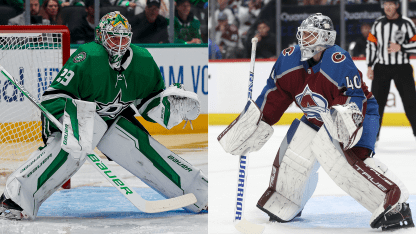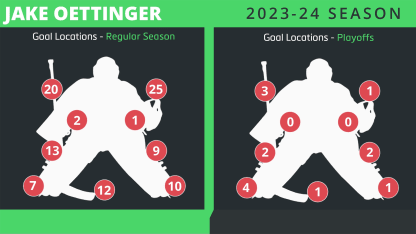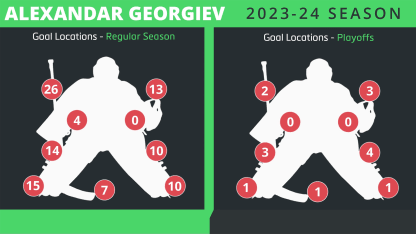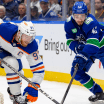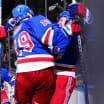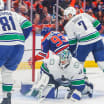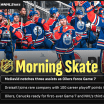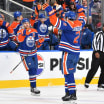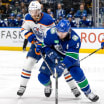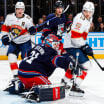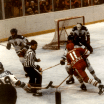Bad angles and pop passes: Oettinger gave up 21 goals on low-to-high passes in the regular season, above the 17.1 percent tracked average of the now more than 7,800 goals tracked for this project since 2017, and another nine on sharp-angle plays originating from below the face-off circle. There was inconsistency on his post-to-post transitions and footwork on plays that moved through the middle of the ice from sharp angles and behind the net that contributed to those totals by delaying his ability to get out and set on pop passes back out front and in-tight lateral plays. There was also a tendency at times to lift his head and shoulders to protect the top corners on sharp angles, which delays tracking and rotation, making quick shots key.
High glove and 5-hole: Seeing the biggest regular-season number over the glove might make it tempting to target, but the reality is these numbers don't represent save percentages, and the 25 high-glove total is only slightly above the 23.6 percent tracked average. The fact that seven of the high-glove goals came on clean looks and another four in 1-on-1, breakaway-type situations, however, makes it a trend worth watching to see if Colorado’s snipers target it. The 12 goals scored five-hole are also right around the average, but there was a trend in some of the open-look goals between the legs worth watching, even if it appears to be one of the things corrected in the late-season surge: Oettinger sometimes retreats before the shot with a double reverse c-cut that widens out his stance and can put him on his heels as he moves, pulling his shoulders back off the release and making it harder to get the pads to the ice to close that five-hole.
Against the grain: Shooting to the side Oettinger is moving away from accounted for 22 goals in the regular season, above the 18.5 percent tracked average, and 6-of-14 in the playoffs, though two of those were tipped. The regular-season trend on rush plays included a tendency to retreat, or drift back, in straight lines which can cause a goalie to lose squareness as the play moves deeper into the zone, exposing more net far side. Starting out above the crease and retreating against the rush can also create vulnerability on passes higher in the zone because being further out early in the sequence increases the lateral distance he needs to cover.
Stretch him out: Scoring chances across the middle of the ice that force a goalie to transition from one side to the other are always a great way to try to score on any goalie, but Oettinger always has excelled against these types of lateral chances. He tends to come across a bit flat with these side-to-side pushes, which helps him close down on shooters on the other end of those passes, but it can leave him prone to being stretched out wide because he doesn't rotate back to his posts as much as others, a tendency that shows up in some of those higher-than-expected -- and average -- goal totals along the ice on either side of the pads.
Active rebounds: Oettinger’s 13 rebound goals in the regular season were only two worse than the tracked average, but it’s important for attacking teams to understand these second chances may not end up in the same place as other goalies. Oettinger uses Bauer pads, which are specifically designed to create notably more active rebounds, making it harder to react to low shots off the pads if you are parked right at the edge of the crease.
Alexandar Georgiev
Colorado Avalanche
Georgiev bounced back from giving up seven goals in Game 1 against the Jets, winning the next four games while giving up eight total goals. The 28-year-old was really good in a first-round loss to the Seattle Kraken in last year’s playoffs, posting a .914 save percentage in his first postseason with the Avalanche, and will need to show he really has rediscovered that form in the second round against the Stars.
